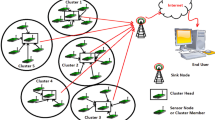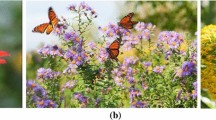Abstract
Clustering is an exploratory data analysis technique that organize the data objects into clusters with optimal distance efficacy. In this work, a bat algorithm is considered to obtain optimal set of clusters. The bat algorithm is based on the echolocation feature of micro bats. Moreover, some improvements are proposed to overcome the shortcoming associated with bat algorithm like local optima, slow convergence, initial seed points and trade-off between local and global search mechanisms etc. An enhanced cooperative co-evolution method is proposed for addressing the initial seed points selection issue. The local optima issue is handled through neighbourhood search-based mechanism. The trade-off issue among local and global searches of bat algorithm is addressed through a modified elitist strategy. On the basis of aforementioned improvements, three variants (BA-C, BA-CN and BA-CNE) of bat algorithm is developed and efficacy of these variants is tested over twelve benchmark clustering datasets suing intra-cluster distance, accuracy and rand index parameters. Simulation results showed that BA-CNE variant achieves more effective clustering results as compared to BA-C, BA-CN and BA. The simulation results of BA-CNE are also compared with several existing clustering algorithms and two statistical tests are also applied to investigate the statistical difference among BA-CNE and other clustering algorithms. The simulation and statistical results confirmed that BA-CNE is an effective and robust algorithm for handling partitional clustering problems.



Similar content being viewed by others
References
Aggarwal CC, Chandan KR (eds) (2013) Data clustering: algorithms and applications. CRC Press, Hoboken
Xu R, Wunsch D (2005) Survey of clustering algorithms. IEEE Trans Neural Netw 16(3):645–678
Kant S, Ansari IA (2016) An improved K means clustering with Atkinson index to classify liver patient dataset. Int J Syst Assur Eng Manag 7(1):222–228
Chang DX, Zhang XD, Zheng CW (2009) A genetic algorithm with gene rearrangement for K-means clustering. Pattern Recogn 42(7):1210–1222
Scheunders P (1997) A genetic c-means clustering algorithm applied to color image quantization. Pattern Recogn 30(6):859–866
Mitra S, Banka H (2006) Multi-objective evolutionary biclustering of gene expression data. Pattern Recogn 39(12):2464–2477
Gomez-Muñoz VM, Porta-Gándara MA (2002) Local wind patterns for modeling renewable energy systems by means of cluster analysis techniques. Renew Energy 25(2):171–182
Nanda SJ, Panda G (2014) A survey on nature inspired metaheuristic algorithms for partitional clustering. Swarm Evol Comput 16:1–18
Karaboga D, Basturk B (2008) On the performance of artificial bee colony (ABC) algorithm. Appl Soft Comput 8(1):687–697
Cura T (2012) A particle swarm optimization approach to clustering. Expert Syst Appl 39(1):1582–1588
Kumar Y, Sahoo G (2014) A charged system search approach for data clustering. Progress Artif Intell 2(2–3):153–166
Jordehi AR (2015) Enhanced leader PSO (ELPSO): a new PSO variant for solving global optimisation problems. Appl Soft Comput 26:401–417
Kushwaha N, Pant M, Kant S, Jain VK (2018) Magnetic optimization algorithm for data clustering. Pattern Recogn Lett 115:59–65
Hatamlou A (2013) Black hole: a new heuristic optimization approach for data clustering. Inf Sci 222:175–184
Karaboga D, Akay B (2009) A comparative study of artificial bee colony algorithm. Appl Math Comput 214(1):108–132
Dorigo M, Maniezzo V, Colorni A (1996) Ant system: optimization by a colony of cooperating agents. IEEE Trans Syst Man Cybern Part B Cybern 26(1):29–41
Jordehi AR (2014) A chaotic-based big bang–big crunch algorithm for solving global optimisation problems. Neural Comput Appl 25(6):1329–1335
Yang XS (2010) A new metaheuristic bat-inspired algorithm. In: Nature inspired cooperative strategies for optimization (NICSO 2010) (pp 65–74). Springer, Berlin, Heidelberg
Ashish T, Kapil S, Manju B (2018) Parallel bat algorithm-based clustering using MAPreduce. Networking communication and data knowledge engineering. Springer, Singapore, pp 73–82
Yilmaz S, Kucuksille EU (2013) Improved bat algorithm (IBA) on continuous optimization problems. Lecture Notes Softw Eng 1(3):279
Fister Jr I, Fister D, Yang XS (2013) A hybrid bat algorithm. ArXiv: 1303.6310
Meng XB, Gao XZ, Liu Y, Zhang H (2015) A novel bat algorithm with habitat selection and Doppler effect in echoes for optimization. Expert Syst Appl 42(17–18):6350–6364
Senthilnath J, Kulkarni S, Benediktsson JA, Yang XS (2016) A novel approach for multispectral satellite image classification based on the bat algorithm. IEEE Geosci Remote Sens Lett 13(4):599–603
Tang H, Sun W, Yu H, Lin A, Xue M (2020) A multirobot target searching method based on bat algorithm in unknown environments. Expert Syst Appl 141:112945
Gan C, Cao W, Wu M, Chen X (2018) A new bat algorithm based on iterative local search and stochastic inertia weight. Expert Syst Appl 104:202–212
Liu Q, Li J, Wu L, Wang F, Xiao W (2020) A novel bat algorithm with double mutation operators and its application to low-velocity impact localization problem. Eng Appl Artif Intell 90:103505
Liu Q, Wu L, Xiao W, Wang F, Zhang L (2018) A novel hybrid bat algorithm for solving continuous optimization problems. Appl Soft Comput 73:67–82
Eskandari S, Javidi MM (2020) A novel hybrid bat algorithm with a fast clustering-based hybridization. Evol Intel 13(3):427–442
Yildizdan G, Baykan ÖK (2020) A novel modified bat algorithm hybridizing by differential evolution algorithm. Expert Syst Appl 141:112949
Ghanem WA, Jantan A (2019) An enhanced Bat algorithm with mutation operator for numerical optimization problems. Neural Comput Appl 31(1):617–651
Cui Z, Li F, Zhang W (2019) Bat algorithm with principal component analysis. Int J Mach Learn Cybern 10(3):603–622
Cai X, Wang H, Cui Z, Cai J, Xue Y, Wang L (2018) Bat algorithm with triangle-flipping strategy for numerical optimization. Int J Mach Learn Cybern 9(2):199–215
Zhu LF, Wang JS (2019) Data clustering method based on bat algorithm and parameters optimization. Eng Lett 27(1):241–250
Shehab M, Khader AT, Laouchedi M, Alomari OA (2019) Hybridizing cuckoo search algorithm with bat algorithm for global numerical optimization. J Supercomput 75(5):2395–2422
Al-Betar MA, Awadallah MA (2018) Island bat algorithm for optimization. Expert Syst Appl 107:126–145
Liu L, Luo S, Guo F, Tan S (2020) Multi-point shortest path planning based on an Improved Discrete Bat Algorithm. Appl Soft Comput 95:106498
Aboubi Y, Drias H, Kamel N (2016) BAT-CLARA: BAT-inspired algorithm for Clustering LARge Applications. IFAC-Papers OnLine 49(12):243–248
Neelima S, Satyanarayana N, Murthy PK (2018) Minimizing frequent itemsets using hybrid ABCBAT algorithm. Data engineering and intelligent computing. Springer, Singapore, pp 91–97
Rahman MA, Islam MZ (2014) A hybrid clustering technique combining a novel genetic algorithm with K-Means. Knowl-Based Syst 71:345–365
Liu R, Jiao L, Zhang X, Li Y (2012) Gene transposon based clone selection algorithm for automatic clustering. Inf Sci 204:1–22
Cao F, Liang J, Jiang G (2009) An initialization method for the K-Means algorithm using neighborhood model. Comput Math Appl 58(3):474–483
Sahoo G (2017) A two-step artificial bee colony algorithm for clustering. Neural Comput Appl 28(3):537–551
Erisoglu M, Calis N, Sakallioglu S (2011) A new algorithm for initial cluster centers in k-means algorithm. Pattern Recogn Lett 32(14):1701–1705
Hatamlou A (2012) In search of optimal centroids on data clustering using a binary search algorithm. Pattern Recogn Lett 33(13):1756–1760
Žalik KR (2008) An efficient k′-means clustering algorithm. Pattern Recogn Lett 29(9):1385–1391
Kumar Y, Singh PK (2019) A chaotic teaching learning based optimization algorithm for clustering problems. Appl Intell 49(3):1036–1062
Fränti P, Sieranoja S (2018) K-means properties on six clustering benchmark datasets. Appl Intell 48(12):4743–4759
Taherdangkoo M, Shirzadi MH, Yazdi M, Bagheri MH (2013) A robust clustering method based on blind, naked mole-rats (BNMR) algorithm. Swarm Evol Comput 10:1–11
Senthilnath J, Omkar SN, Mani V (2011) Clustering using firefly algorithm: performance study. Swarm Evol Comput 1(3):164–171
Han X, Quan L, Xiong X, Almeter M, Xiang J, Lan Y (2017) A novel data clustering algorithm based on modified gravitational search algorithm. Eng Appl Artif Intell 61:1–7
Zhang C, Ouyang D, Ning J (2010) An artificial bee colony approach for clustering. Expert Syst Appl 37(7):4761–4767
Yan X, Zhu Y, Zou W, Wang L (2012) A new approach for data clustering using hybrid artificial bee colony algorithm. Neurocomputing 97:241–250
Kumar Y, Sahoo G (2015) Hybridization of magnetic charge system search and particle swarm optimization for efficient data clustering using neighborhood search strategy. Soft Comput 19(12):3621–3645
Zhou Y, Zhou Y, Luo Q, Abdel-Basset M (2017) A simplex method-based social spider optimization algorithm for clustering analysis. Eng Appl Artif Intell 64:67–82
Boushaki SI, Kamel N, Bendjeghaba O (2018) A new quantum chaotic cuckoo search algorithm for data clustering. Expert Syst Appl 96:358–372
Chang D, Zhao Y, Zheng C, Zhang X (2012) A genetic clustering algorithm using a message-based similarity measure. Expert Syst Appl 39(2):2194–2202
Xiao J, Yan Y, Zhang J, Tang Y (2010) A quantum-inspired genetic algorithm for k-means clustering. Expert Syst Appl 37(7):4966–4973
Bijari K, Zare H, Veisi H, Bobarshad H (2018) Memory-enriched big bang–big crunch optimization algorithm for data clustering. Neural Comput Appl 29(6):111–121
Abualigah LM, Khader AT, Hanandeh ES, Gandomi AH (2017) A novel hybridization strategy for krill herd algorithm applied to clustering techniques. Appl Soft Comput 60:423–435
Pakrashi A, Chaudhuri BB (2016) A Kalman filtering induced heuristic optimization based partitional data clustering. Inf Sci 369:704–717
Kang Q, Liu S, Zhou M, Li S (2016) A weight-incorporated similarity-based clustering ensemble method based on swarm intelligence. Knowl-Based Syst 104:156–164
Wang R, Zhou Y, Qiao S, Huang K (2016) Flower pollination algorithm with bee pollinator for cluster analysis. Inf Process Lett 116(1):1–14
Hatamlou A, Hatamlou M (2013) PSOHS: an efficient two-stage approach for data clustering. Memetic Comput 5(2):155–161
Jiang B, Wang N (2014) Cooperative bare-bone particle swarm optimization for data clustering. Soft Comput 18(6):1079–1091
Kumar Y, Singh PK (2018) Improved cat swarm optimization algorithm for solving global optimization problems and its application to clustering. Appl Intell 48(9):2681–2697
Kwedlo W (2011) A clustering method combining differential evolution with the K-means algorithm. Pattern Recogn Lett 32(12):1613–1621
Yin M, Hu Y, Yang F, Li X, Gu W (2011) A novel hybrid K-harmonic means and gravitational search algorithm approach for clustering. Expert Syst Appl 38(8):9319–9324
Jiang H, Yi S, Li J, Yang F, Hu X (2010) Ant clustering algorithm with K-harmonic means clustering. Expert Syst Appl 37(12):8679–8684
Kaur A, Kumar Y (2021) A new metaheuristic algorithm based on water wave optimization for data clustering. Evol Intell 2021:1–25
Kuo RJ, Zheng YR, Nguyen TPQ (2021) Metaheuristic-based possibilistic fuzzy k-modes algorithms for categorical data clustering. Inf Sci 557:1–15
Hu KC, Tsai CW, Chiang MC (2020) A multiple-search multi-start framework for metaheuristics for clustering problems. IEEE Access 8:96173–96183
Aljarah I, Mafarja M, Heidari AA, Faris H, Mirjalili S (2020) Clustering analysis using a novel locality-informed grey wolf-inspired clustering approach. Knowl Inf Syst 62(2):507–539
Zhou X, Zhang R, Wang X, Huang T, Yang C (2020) Kernel intuitionistic fuzzy c-means and state transition algorithm for clustering problem. Soft Comput 24(20):15507–15518
Jensi R, Jiji GW (2016) An improved krill herd algorithm with global exploration capability for solving numerical function optimization problems and its application to data clustering. Appl Soft Comput 46:230–245
Hatamlou A (2017) A hybrid bio-inspired algorithm and its application. Appl Intell 47(4):1059–1067
Bouyer A, Hatamlou A (2018) An efficient hybrid clustering method based on improved cuckoo optimization and modified particle swarm optimization algorithms. Appl Soft Comput 67:172–182
Xiang WL, Zhu N, Ma SF, Meng XL, An MQ (2015) A dynamic shuffled differential evolution algorithm for data clustering. Neurocomputing 158:144–154
Author information
Authors and Affiliations
Corresponding author
Additional information
Publisher's Note
Springer Nature remains neutral with regard to jurisdictional claims in published maps and institutional affiliations.
Rights and permissions
About this article
Cite this article
Kumar, Y., Kaur, A. Variants of bat algorithm for solving partitional clustering problems. Engineering with Computers 38 (Suppl 3), 1973–1999 (2022). https://doi.org/10.1007/s00366-021-01345-3
Received:
Accepted:
Published:
Issue Date:
DOI: https://doi.org/10.1007/s00366-021-01345-3




